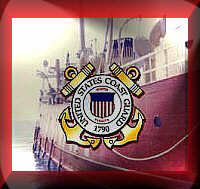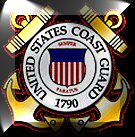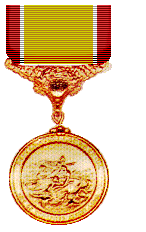









By Captain W. Russell Webster,
USCG
[The following article appeared in the December 2001 Naval Institute Proceedings (Vol 127, pp. 66-69).
It has been 50 years since BM1 Bernard Webber and his all-volunteer crew of three ventured out over the Chatham, Massachusetts bar in a 36-foot wooden motorized lifeboat in 60-foot seas and 70-knot wind and rescued 32 crewmen from the stricken tank vessel Pendleton. Despite the passage of a half-century, memories, especially the horrific death of a thirty-third crewman during the rescue, are still vivid in the mind of the 73-year-old small boat coxswain.
This is a story of unparalleled heroism by a Coast Guard small boat crew
Pendleton’s voyage. The 503-foot, 10,448 gross ton tank vessel Pendleton (T2-SE-A1 or “T2”) was built by the Kaiser Company in 1944 and departed Baton Rouge, LA on February 12, 1952. It was laden with a full cargo of 122,000 barrels of kerosene and heating oil. The ship carried a crew of 41, including the master, Captain John Fitzgerald. Late on the evening of 17 February, Pendleton arrived off Boston. The weather was foul with extremely limited visibility. The captain opted to stand off and headed his vessel east-northeast at slow speed into Massachusetts Bay into the prevailing sea conditions. The wind and sea conditions worsened throughout the night, building into a full-scale ‘Nor’easter’ gale with snow and high seas. 2
At about 5:50 a.m. on 18 February,
after a series of explosive cracking noises, the Pendleton took a heavy
lurch and broke in two.4 At the time of the break, the vessel’s
circuit breakers tripped, leaving the bow section without power. The stern
section continued to operate normally, including all machinery and lighting.
 Gone with the darkened bow section were the Captain and seven other crewmen, all
destined to perish. In the stern, the Chief Engineer, Raymond Sybert,
immediately took charge and mustered his 32 survivors and assigned them duties.
Gone with the darkened bow section were the Captain and seven other crewmen, all
destined to perish. In the stern, the Chief Engineer, Raymond Sybert,
immediately took charge and mustered his 32 survivors and assigned them duties.
Alone, adrift, in mountainous seas, the stern
section and its human cargo drifted south with a slight port list about six
miles off Cape Cod. The bow section also drifted south, but at a further
distance offshore. No S.O.S. had been issued.
(Left) The bow of the Pendleton.
The Rescue
February 18, 1952 saw the Coast Guard
rescue a total of 70 men from two T2 tank vessels, the Fort Mercer and
the Pendleton. Both tankers split in half off Cape Cod. The T/V
Mercer about 20 miles offshore, the T/V Pendleton about 10 miles. By
noon on 18 February, there were four separate hulks adrift off Cape Cod.
By mid-morning on February 18, the men at the Chatham Lifeboat Station (today known as Chatham Coast Guard Station) received word about the T/V Fort Mercer’s predicament. Orders were received for the station to launch a motorized lifeboat (MLB) to assist the Fort Mercer.
At noon, the station Officer in Charge, Bos’n Cluff, ordered BMC
Donald Bangs to select his crew and man the CG-36383 MLB at Stage Harbor
and proceed to assist the T/V Fort Mercer. At the time, BM1 Webber,
chosen to remain behind for other duties, thought “My God, do they really think
a lifeboat and its crew could actually make it that far out to sea in this storm
and find the broken ship amid the blinding snow and raging seas with only a
compass to guide them? If the crew of the lifeboat didn’t freeze to death first,
how would they be able to get the men off the storm-tossed sections of the
broken tanker?5 He would soon find out.
Shortly after Chief Bangs and his crew left to assist
the Fort Mercer, BM1 Webber was ordered to the Chatham Old Harbor area
where he and his crew would spend the next several hours helping local fishermen
re-moor their fishing vessels which had been moved by the ongoing Nor’easter.
Back on the stern section of the Pendleton, Engineer Sybert’s
crew sighted the beach at about two p.m. At 2:55 p.m., the Chatham Lifeboat
Station’s (CLS)’ radar picked up two blips about five and a half miles
distant. At 3:00 p.m., Bos’n Cluff visually sighted the bow section of the
Pendleton. Cluff’s report to the Boston regional Coast Guard headquarters
caused Coast Guard PBY aircraft No. 1242 to be diverted from ongoing rescue
operations further offshore involving the Fort Mercer. Shortly after 4
p.m., the PBY made the first positive identification of both sections of the
Pendleton. The Coast Guard now knew for the first time it had two
stricken T2 tankers and four different possible rescue situations.6
Bos’n Cluff’s initial reaction was to dispatch his remaining crew,
including BM1 Webber, to the North Beach area (between Orleans and Chatham) in
hopes they could render assistance to Pendleton’s crew if either section of the
vessel came ashore.It soon became apparent that neither section would come
ashore there and the crew returned to the station to prepare to use the
CG-36500 MLB to render aid.
The Pendleton’s stern section and its crew of 33 drifted close to shore. Close enough that local residents could occasionally hear the ship’s whistle and see the vessel as it “galloped along up and down huge waves, frothing each time it rose or settled back into the sea.
Bos’n Cluff then ordered, “Webber, pick
yourself a crew. Ya-all got to take the 36500 out over the bar and assist that
thar ship, ya-heah?” With great trepidation having seen the conditions offshore
and knowing his likely fate, but understanding his duty, he replied, “Yes sir,
Mr. Cluff, I’ll get ready.”7
It was time to choose his crew. Only three men were available, since
“other crew members had made themselves scarce when they heard that CG-36500
was to be sent.” 8
All three quickly volunteered. BM1 Webber’s
volunteers included the station’s junior engineer, Engineman Andrew Fitzgerald,
Seaman Richard Livesey, and a crewman from the nearby Stonehorse Light Ship,
Seaman Irving Maske, who had been waiting for transportation back to his
lightship.
At about 5:30 p.m., as BM1 Webber and his crew readied their dory to row out to the CG-36500 MLB, local fisherman and neighbor, John Stello, yelled out over the din: “You guys better get lost before you get too far out.”9
Webber knew all too
well what his friend was suggesting. Go out and probably die or get lost and
live other days to talk about it. Webber asked Stello to call his wife Miriam,
who had been alone and sick at home for two days, and let her know about the
rescue attempt.
At 5:55 p.m., Webber and his last-minute-crew left
the pier in their wooden 36-foot-long motorized lifeboat driven along by its
single 90 horsepower gas engine.As coxswain Webber turned his lifeboat into the
channel, he could see the station’s lights and hoped for a hasty recall.
Hearing nothing, he radioed the station and received the curt response “Proceed
as directed.”10
Back on the Pendleton’s stern,
Engineer Sybert saw the stern section headed for grounding on Chatham’s bar and
certain disaster. Sybert used the tanker’s engines to keep the tanker off the
bar, but this only increased the vessel’s list and trim dangerously. When some
of Sybert’s crew heard that a motor lifeboat from Chatham was on the way on
their personal radios, efforts to maneuver the stern were stopped. As the CG-36500 approached Chatham’s bar, Webber and his crew began to
sing Rock of Ages and Harbor Lights.11 Their voices were soon
muffled by the thunderous roar of the ocean as it collided with the sand bar.
As the CG-36500 approached Chatham’s bar, Webber and his crew began to
sing Rock of Ages and Harbor Lights.11 Their voices were soon
muffled by the thunderous roar of the ocean as it collided with the sand bar.
As the CG-36500 crossed the bar, the boat
was smashed by a mountain of a wave and thrown high in the air. The boat landed
on its side between waves. The self-righting boat recovered quickly and was
smote again, this time tons of seawater crashed over the boat breaking its
windshield and flattening coxswain Webber.
Quickly scampering to his feet, Webber noticed the
boat’s compass had been knocked off its mount. The cold, near hurricane force
winds howled through the boat’s cockpit as Webber struggled to regain control
and steer in to the towering waves.
The Pendleton’s engineer and his crew
sensed their demise as the stern hulk hobby-horsed southward smashing bottom
with each new series of waves. Although there were several Coast Guard cutters
and the CG-36383 nearby, the fortunes of fate would only allow
CG-36500 and her crew alone one attempt to save engineer Sybert’s men.
Coxswain Webber finally brought CG-36500
across the bar and knew the water was deeper because the spacing between the
waves had increased and so had the wave heights. Weather observations from
nearby cutters involved in the Fort Mercer and Pendleton rescues
indicated sea heights between 40 to 60 feet.13
Occasionally, the lifeboat’s engine would die out when the waves would roll the vessel so far over that the gasoline engine would lose its prime. Each time, engineer Fitzgerald would crawl into the cramped compartment to restart the main engine --- his efforts were rewarded with severe burns, bruises, the steady chug-chugging of the engine and the collective sighs of appreciation from his shipmates.
The boat proceeded roller coaster fashion
as it slowly labored up one side of a huge wave and surfed down the backside,
accelerating towards the trough. Coxswain Webber knew too much speed was not
good and unchecked, would cause the boat’s bow to bury in the next wave and
swamp the small vessel.14
The boat’s motion was so swift, coxswain Webber had to reverse the engine on the backside of each wave in order to slow it down. His first navigational waypoint was the nearby Pollock Rip Lightship, where Webber hoped to reorient himself and give his crew a breather in the lee of the larger vessel.
The weather and visibility worsened in freezing horizontal snow that lashed the coxswain’s face through the broken windshield. He wore no lifejacket in order to give himself the best chance to react and guide the vessel.
After about an hour of struggling and fearing he had missed the lightship, coxswain Webber slowed the CG-36500 to a near standstill as he sensed, rather than saw, something ahead. He sent a crewman forward to energize the boat’s small searchlight. Within seconds, the light was on and a large wave lifted this crewman up and over the coxswain flat and carried him aft where he landed onboard, miraculously unhurt, with a thud.
Creeping the boat forward, the searchlight soon revealed a pitch black mass of twisted METAl, which heaved high in the air upon the massive waves and then settled back down in a “frothing mass of foam.” Each movement of the giant hulk produced a cacophony of eerie groans as the broken ship twisted and strained in the 60-foot seas. No lights were apparent as coxswain Webber maneuvered the small boat aft along the port side of the Pendleton’s stern section.
Rounding the stern, CG-36500’s
searchlight illuminated the word PENDELTON and moments later, the larger
vessel’s own deck lights became apparent. And, then a small figure above began
frantically waving his arms! He soon disappeared.
Coxswain Webber then saw a mass of people begin to
line Pendleton’s starboard stern area, many shouting muffled instruction,
which were unintelligible over the wind and crashing seas. He looked upon their
position as “inviting” relative to his own and thought of strategies for he and
his crew to join them above.16
Without notice, a Jacob’s ladder was tossed over
the side, and unbelievably, men began to start down the ladder like a procession
of ants! The first man at the bottom was dunked in the water like a tea bag and
then lifted 50 feet in the air as the Pendleton rolled and heaved. Webber
sent his crew forward to assist.
Coxswain Webber skillfully maneuvered the
CG-36500 along the Pendleton’s starboard quarter and, one by one, the
Pendleton survivors either jumped and crashed hard on the tiny boat’s bow
or fell in to the sea, where Webber’s crew assisted them onboard at great
personal risk. Some Pendleton crewmen were sling-shotted out from the
ship on the Jacob’s ladder by the whipping and rolling motion of the waves. As
soon as they had reached their zenith of flight, the ship would snap roll them
back violently and slam them against the side of the Pendleton.
After multiple approaches and 20 survivors safely
recovered, the CG-36500 began to handle sluggishly. The human parade
continued to descend unabated. There was no turning back as coxswain Webber
arrived at yet another defining moment and made the decision that they would all
live or they all would die.17
Myers jumped too
soon and was swallowed up by the sea. Moments later, he was again visible
underneath the stern of the vessel, clinging to one of Pendleton’s
11-foot-long propeller blades.
Easing ahead cautiously, Webber felt the stern of
the small boat rise as a monstrous wave overtook CG-36500.The boat was
driven ahead faster and faster towards Myers. Coxswain Webber backed his small
craft’s engine hard, but the boat smashed into Pendleton and Tiny Myers.
The CG-36500 was ejected from underneath the Pendleton by another
large wave just as the hulk was lifted one last time and rolled over and sank.
All was again dark as the CG-36500’s searchlight was extinguished. Coxswain Webber was sick at the thought of losing Tiny Myers, but knew the fate of the 36 men on his small boat rested exclusively in his hands.
Lost with no compass to steer by and in zero visibility conditions, there were just two choices. Head east into the seas and hope to survive 10-12 more hours until a new day’s light brought the slim chance of transferring passengers yet again to a larger rescue ship. Or, put the wind and seas on the small boat’s stern and let them force the vessel ashore someplace where help might be nearby.
Coxswain Webber then tried his radio
again and received an immediate acknowledgement. Once he briefed his superior
that he had 32 Pendleton survivors aboard, there ensued a squabble
between the nearby CG cutter McCulloch and the Chatham Lifeboat Station
about various options. These included a suggestion of an at-sea rendezvous with
McCulloch and a second transfer of survivors! The radio was quickly
turned off and Webber devised a plan to beach the CG-36500 at first
opportunity. The small vessel would be held on the beach as long as possible
with the engine while the survivors clambered ashore. On cue, the Pendleton
crew gave a cheer of approval and support and on they went.
A quick call to the station was met with excitement and elation for
now everyone knew that the rescued were now survivors! Soon, another stream of
over-direction and gibberish caused coxswain Webber to secure the radio after
requesting assistance with the survivors at the fish pier.
A crowd of Chatham men, women and children met the CG-36500 at
the pier, securing lines and helping the shocked, excited and in some cases,
sobbing survivors and rescuers ashore.

Webber and his crew arrive back safely at their
base with 32 of the Pendleton's survivors on board the Coast Guard motor
lifeboat.
 Coxswain Webber saw his friend and fisherman John
Stello once again and inquired about what the sick Miriam Webber had said when
she learned of the CG3-6500’s return? Stello replied that he had told
Webber’s wife Miriam that Webber was a hero, but she was too ill to comprehend.
Webber would not make it home for several days even though he lived just five
minutes from the station.21
Coxswain Webber saw his friend and fisherman John
Stello once again and inquired about what the sick Miriam Webber had said when
she learned of the CG3-6500’s return? Stello replied that he had told
Webber’s wife Miriam that Webber was a hero, but she was too ill to comprehend.
Webber would not make it home for several days even though he lived just five
minutes from the station.21
In
a message to the Chatham Lifeboat Station the day after the rescue, Rear Admiral
H. G. Bradbury, Commander of the First CG District, sent his personal
congratulations to BM1 Webber and his crew for their “outstanding seamanship and
utter disregard of your own safety in crossing the hazardous waters of Chatham
bar in mountainous seas extreme darkness and falling snow during a violent
winter gale to rescue from imminent death thirty two crewmembers… minutes before
the tanker capsized.”22
(Left) Relief shows on the faces of the weary Coast Guard rescuers. SN Irving Maske (foreground) and BM1 Bernard Webber in the coxswain's flat on board the CG-36500. Photo by Richard C. Kelsey, Chatham, Mass. Photo credit: Cape Cod Community College.

Another view of the Coast Guard
crew and the rescued Pendleton sailors as they disembark from CG-36500.
Photo credit: Cape Cod Community College.

The original caption stated: "Rescuers discuss the rescue. Left to right are
Coast Guardsmen Bernard Webber, who piloted the rescue boat; Engineman second
class Andrew Fitzgerald, Seaman Richard Livesey and Seaman Irving Maske. Photo
by Richard Kelsey, Chatham." Photo credit: Cape Cod Community College.
BM1 Bernard C. Webber, USCG of Chatham,
Massachusetts, and his three volunteer crew members all received the Treasury
department’s coveted Gold Lifesaving Medal for “extreme and heroic daring”
during the Pendleton rescue.23
Notes
1. O’Neil, Merlin, VADM, USCG Commandant’s remarks at a Department of Treasury Awards Ceremony, 14 May, 1952.
2. U.S. Coast Guard Commandant, Merchant Vessel Inspection Division, Marine Board of Investigation; structural failure of tanker Pendleton off Cape Cod on 18 February 1952, with loss of life, 25 September 1952.
3. U.S. Coast Guard Commandant, Merchant Vessel Inspection Division, Marine Board of Investigation; structural failure of tanker Pendleton off Cape Cod on 18 February 1952, with loss of life, 25 September 1952.
4. Ibid. The Coast Guard’s Board of Investigation concluded that the low temperatures on 2/18/52 tended to increase the notch sensitivity of the Pendleton’s steel resulting in brittle fractures. Pendleton’s condition of loading and ballasting with excessive buoyancy in the bow and stern and heavy weight amidships created a sagging effect, which was aggravated by the extremely heavy seas. The board concluded the fracture of the hull was caused by failure of material under stress due to low temperature on a tension setup by the condition of loading and the situation of the vessel in an extremely rough sea.
5. Webber, Bernard C., ‘Chatham, “The Lifeboat Men,”’ Lower Cape Publishing Co., 1985, p. 43.
6. Hathaway, Charles, B., CAPT, USCG, (Ret.), ‘From Highland to Hammerhead,’ The Coast Guard and Cape Cod, Library of Congress Catalog card Number 00-130105, 2000, p. 133 and commander, first Coast Guard District One Boston Massachusetts’ messages 182150Z February 1952 and 191615Z February, 1952.
7. Webber, Bernard C., ‘Chatham, “The Lifeboat Men,”’ Lower Cape Publishing Co., 1985, p. 46.
8. Webber, Bernard C., Letter to the author of 27 September 2001
9. Ibid. p. 46.
10. Ibid. p. 47.
11. Ibid.
12. Ibid.
13. Commander, Coast Guard District One, Boston , MA. Record messages 181948Z February, 1952 and 191615Z February 1952 indicated “near hurricane force winds’ and that the much larger Coast guard cutters McCulloch and Legare had suffered extensive weather damage during the rescue including hull damage – cracked plates and loss of life boats.
14. Webber, Bernard C., ‘Chatham, “The Lifeboat Men,”’ Lower Cape Publishing Co., 1985, p. 47-48.
15. Ibid.
16. Ibid.
17. Ibid.
18. Ibid.
19. Hathaway, Charles, B., CAPT, USCG, (Ret.), ‘From Highland to Hammerhead,’ The Coast Guard and Cape Cod, Library of Congress Catalog card Number 00-130105, 2000, p. 135.
20. Coast Guard Air Station Salem, MA record message 182220Z February 1952. The CG’s PBY aircraft thought Chatham’s Life Boat was ‘experiencing radio troubles.”
21. Webber, Bernard C., Letter to the author of 27 September, 2001.
22. Commander, First CG District Boston, MA record message 192129Z February 1952.
23.
In all, 24 Coast Guardsmen were honored for their efforts during the Fort
Mercer-Pendleton rescues. Seventy of the possible 84 crewmen were eventually
saved from the broken vessels. Five Gold Lifesaving Medals, four Silver
Lifesaving Medals and 15 Coast Guard Commendation Ribbons were awarded to the
rescuers. On average, five Gold Lifesaving Medals and 10-12 Silver Lifesaving
Medals are awarded each year for acts of heroism on the water.
Final Page of this report>>>>>>>>>>>
Copyright 2004 United States Coast Guard Lightship Sailors by MGM IMAGING . All rights reserved.
Copyrights also protected by the Digital Millennium Copyright Act of 1998 Revised: 05/15/07.